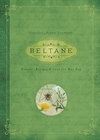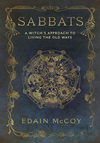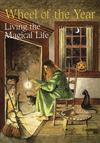Beltane and May Day Customs

The celebration of May features the festival of Beltane, which is held on May Eve or the first day of May. May Day celebrations are well noted in the 19th century; however, there is little evidence available to indicate the specific historical origins. Some commentators believe that the rites of Beltane are traceable to the ancient Roman festival of Floralia, which was celebrated with floral processions. Others believe it originated among the Celts that inhabited the British Isles.
Whatever the origins of May Day or Beltane are, it is still celebrated as a time of renewal within nature. Beltane can also be regarded as a celebration in anticipation of the coming summer season. In modern Wicca the rite of Beltane is an observance of the courtship of the Goddess and God whose union rejuvenates the earth. From this union the world becomes abundant with the bounty of nature.
Flowers, branches, and garlands feature prominently in the merriment of May. The old tradition in Greece was to gather flowers on the morning of May 1st, and afterward to fasten them to the doors or windows of houses and merchant shops. In parts of England the May customs involved the carrying of May dolls by young girls, while young boys carried a bullock's horn. The boys and girls also carried a sprig from narrow-leaf elm tree. The underlying theme of such practices is one of fertility.
One lovely custom of the May Day celebration, once popular in parts of England, involved going door-to-door and caroling. Among the common songs the following is one of the oldest and most representative of oral tradition:
I wish you a happy day;
I'm come to show my garland,
because it's the First of May.
A bunch of May I have brought you,
and at your door it stands;
it is but a spray, but it's well spread about,
" Tis the work of the Fays' hands.
And now I've sung my little short song,
no longer can I stay;
Faeries bless you all, both great and small,
and grant you a very happy May."
In Scotland the celebration of May included the gathering of rowan tree branches and other greenery and flowers. One of the oldest Scottish customs was for young women to climb to the top of a hill to see the sunrise rise on the first day of May. The women would then wet their faces with the morning dew in a belief that this would bestow greater beauty in the months ahead.
In old England the celebration of May featured a woman bearing the title and office of the Queen of May or the May Queen. It seems to have been the custom, at the celebration of the May-games, to elect a Lord and Lady of the May to preside over the festivities. The Lord of the May was decorated with scarves, ribbons, and other fineries. Traditionally the Lady wore a garland and crown made of the following flowers: tulips, anemones, cowslips, kingcups, meadow-orchids, wall-flowers, primroses, crown-imperials, lilacs, laburnums, roses (and other available bright flowers of all descriptions). A large doll, which was known as Madame Flora, accompanied the May Queen. The figure was suspended from a pyramid-like configuration of evergreen boughs decorated with nosegays. Ribbons and colorful fabrics hung as streamers from the base of the nosegays. The procession ended in a mock marriage to the King of May. Here again we see the underlying theme of fertility associated with the rites of May.
One of the most popular features of the May celebration is the Maypole. Part of the symbolism of the Maypole dance is the wedding of the May Queen and May King. The dance involves the braiding of colored ribbons suspended from a long pole. This represents the joining and entwining of the fertile forces of nature that are personified as Queen and King.
The Maypole is traditionally nine feet tall. Colored ribbons are attached to the top of the pole. These consist of an equal number of ribbons or streamers. A minimum of two ribbons is used, and the traditional colors are red and white; the ribbons are twice as long as the length of the Maypole. The end of each ribbon is held by an individual dancer. As the dance commences, the dangling ribbons begin to be braided through the movements of the dancers.
An even number of persons is required for this dance; half the number takes the end of a ribbon in the right hand and the other half in the left. The dancers then stand across from each other, facing alternately right and left. When the dance commences, each dancer facing the right passes under the ribbon held by the one opposite (who faces the left). Each dancer allows the next person going to the left to pass under his or her ribbon, and so on, moving in and out, under and over as the ribbons are woven around the pole.
In one variation of the dance the participants separate into two equal divisions, and each party, independent of the other, plaits a strip which hangs loosely from the pole. In performing this variation the two parties stand on either side of the pole, and all those facing the right pass on in that direction, going in and out until the last person going to the right has passed the last person going to the left in her division. During this phase the ribbons are transferred ribbons to their other dancers' hands as they all turn and reverse order. They continue going back and forth until the plait is about a foot in length, when another change is made by the two parties joining forces again. This time, all those facing the left proceed in that direction, passing under the ribbons of all the others who are going to the right, thus forming two circles, one within the other. After going twice around the pole in this order, the dancers composing the inner circle take the outside and the others pass beneath their ribbons, again circling the pole twice. After going through the first figure once more, the dance may be ended or the whole order may be reversed. The latter choice will unplait the ribbons around the Maypole.
An interesting character associated with May Day celebration is known as Jack-in-the-green. In old street processions he was accompanied by a band of chimney sweeps and a man known as the whistler. On May Day, in an old custom, the chimney sweeps were called the clergy. They constructed a Jack-in-the-green figure, which was carried through the streets during the May Day festival. It is traditionally composed of a framework of old hoops, connected by uprights of flexible wood. The framework is covered with green baize, and on to this the boughs are attached, which make the green. Sometimes the Jack-in-the Green is a man dressed with ribbons and flowers. Traditionally he carries a long walking stick with a floral wreath.
Many of the old May Day customs began to disappear in the later half of the 19th century. The society of chimney-sweeps kept up the customs longest, coming out in force, dressed up with fantastic hats and colored ribbons. In the midst was a moving arbor of green branches and flowers; this was the classic Jack in the Green. Beside him ran and danced a girl in festive colors, who was called Maid Marian. Preceding the Jack-in-Green marched a fife & drum or a fiddler, and they stopped at certain points to dance round Jack in the Green. During the procession the chimney-sweepers carry their shovels and brushes in their hands, which they rattle together, and to this rough music they jump about in imitation of dancing.
Another procession consisted of the milkmaids. These dairy women came dressed in bright colors with flowers in their hair or in their hats. They led along a milk cow covered with garlands, and they carried pails ornamented with ribbons and flowers. During the procession the maids would stop to dance the cow to the music of the violin or clarinet. At an earlier time, instead of a cow, there was a costumed man dressed similar to Jack-in-the-green. He was encased in a frame that covered the upper half of his body. On this frame hung clusters of silver flagons and tankards each set in a bed of flowers. Alongside this figure walked a fiddler that was always represented as one-legged.
In the early half of the 16th century the stories of Robin Hood and his companions were introduced into the pageantry of the May-games. He was one of the legendary characters that the populace were fond of impersonating (particularly in the plays performed by the Morris dancers in association with May Day). It is perhaps for this reason that the May celebration was sometimes called Robin Hood's Festival. According to legend Robin reportedly died on the first of May, which no doubt connected his legend to this celebrator season.
In the May celebrations the Robin Hood figure appeared as the Lord of the May, accompanied by his faithful mistress, the Maid Marian, who took on the role of Lady of the May. His companions wore the traditional hunting garb of foresters. So popular was the inclusion of Robin Hood that notes were sometimes found on church doors explaining that the church was closed because the parishioners were out gathering for Robin Hood and the May games. This was not only the case in England, but the General Assembly in Scotland twice requested (in 1577 & 1578) that the king prohibit plays of "Robin Hood, King of May" held on the Sabbath day. Some commentators believe that the popularity of Robin Hood in the May celebrations is rooted in the figure itself being of pagan origins. In this context Robin Hood represents a pagan deity associated with spring and vegetation, which may be a form of the classic Green Man.
In modern times the first of May is celebrated by many contemporary Pagans, Wiccans, and Witches as a Beltane ritual. In modern times, as it was long ago, Beltane features a bonfire symbolizing the coming of summer. Dancers perform around the blazing fire to the rhythm of drums. For many dancers the dance is an ecstatic experience, and each person enters into a relationship with the fire itself as though it were a living being.
The name Beltane has its roots in the Celtic word tein, which means fire. The etymology of Beltane is debatable. One theory is that the ancient deity associated with the May season was Baal, and in this context we have Baal-tein, the fire of Baal. Baal was also known as Bel, and over the course of time the name Beltane prevailed. The second theory is that Beltane is derived from bea'uil, which is related to Beal and teine. From this combination we can arrive at Beal teine, or Beltane. The term bea' uil means the life of everything or the source of everything. However, according to some commentators, Beltane is derived from two Gaelic words co joined to form the name Paleteia which means Pales' fire (as opposed to Baal's fire). The goddess Pales was the Roman deity of cattle, pastures, and shepherds. We may never be certain of the origins of Beltane, but the spirit of Beltane remains with us to this very day.
The sacredness of the Beltane fire is expressed in the ancient practice of lightning a needfire. This was done to purify the land and its people as well as to reawaken the spirit of the region. When harsh times and decline befell a community all fires in the area were extinguished. A large bonfire was then ignited on a hilltop, and from this sacred fire torches were lighted. The torches were then carried into the villages to relight the hearth fires of the homes. From this single bonfire light was reborn in the kingdom. This ancient concept of renewal is a theme that can and should be incorporated into our modern Beltane celebration. May the new light and the inherent sacredness of the Beltane season reawaken the vital and sustaining spirit of our own homeland.

About Raven Grimassi
Related Products



is subject to certain Terms and Conditions